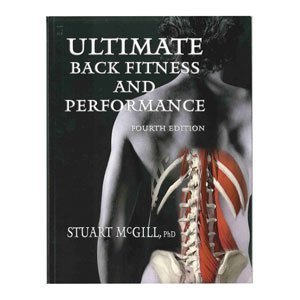Why Sit-ups Aren’t Going to Kill You
So there’s a lot of trainers out there who seem to be jumping on the whole “crunches are bad for you because anything spinal flexion will make the discs of your spine shoot across the room, make your poop turn purple and make you the son of the devil,” band wagon. While I agree there’s a time and place for everything, and that spinal flexion based exercises are often done incorrectly, do we really need act like the floor is going to rip open and swallow us whole if we ever do an ab isolation exercise for flexion?? Didn’t think so, huh? Maybe this is a situation where trainers can’t assume they have it right.
 So let’s find out where this all started. Dr. Stuart McGill, whom I have nothing but respect for and think is a freakin genius when it comes to spinal mechanics and lumbar spine injuries, wrote a couple of well-received books that were primarily based on the research he’s conducted in his lab in Waterloo, Ontario. In Ultimate Back Fitness and Performance, 4th edition,
So let’s find out where this all started. Dr. Stuart McGill, whom I have nothing but respect for and think is a freakin genius when it comes to spinal mechanics and lumbar spine injuries, wrote a couple of well-received books that were primarily based on the research he’s conducted in his lab in Waterloo, Ontario. In Ultimate Back Fitness and Performance, 4th edition,
 he showed that prolonged spinal flexion would reduce the threshold to the tissues involved (specifically the discs and intervertebral ligamental structures) to resist a buckling injury. By being placed in a spinal flexion posture, the discs of the lumbar spine, which are commonly angulated to provide more extension with the majority of their mass in the front and little in the back, are forced to move the bulk of their nucleus to the back and strain against the annular fibres, sometimes resulting in herniation. He also directly states that:
he showed that prolonged spinal flexion would reduce the threshold to the tissues involved (specifically the discs and intervertebral ligamental structures) to resist a buckling injury. By being placed in a spinal flexion posture, the discs of the lumbar spine, which are commonly angulated to provide more extension with the majority of their mass in the front and little in the back, are forced to move the bulk of their nucleus to the back and strain against the annular fibres, sometimes resulting in herniation. He also directly states that:
…herniation of the disc seems impossible without full flexion. Thousands of flexion cycles are needed to herniate a disc.
At this point a lot of trainers started jumping on the “flexion is bad” bandwagon. Reading further, in McGills Low Back Disorders,
he showed how a sit-up can cause up to 730 pounds of compressive force in the spine, far above the National Institute for Occupational Safety and Health’s recommended guidelines for compressive force during work, even going so far as to say that each sit-up will make a client remain a patient.
The funny thing is, he also included a short graph outlining the compressive effect on the spine of a couple of exercises, and while situps with straight legs produced 3506 Newtons of compressive force, a basic curl-up produced 1991 Newtons of force, well below the level recommended by NIOSH. So if a sit-up was bad for you because it produced so much compression, is a crunch better because it doesn’t produce as much compression? Apparently not, since all flexion based movements are bad for you.
 While I’ll agree with the measurements taken, and the design showing that flexion-based exercises may be increasing stress on the spine, specifically on the discs, end plates, and ligamental structures, I don’t think we should avoid all flexion-based movements, and feel that crunches, WHEN DONE PROPERLY, are an amazing exercise to increase ab strength through saggital plane loading and to actually promote spine health. Hell, McGill even gives examples of crunches to do and ways to promote spine support while doing them!!!
While I’ll agree with the measurements taken, and the design showing that flexion-based exercises may be increasing stress on the spine, specifically on the discs, end plates, and ligamental structures, I don’t think we should avoid all flexion-based movements, and feel that crunches, WHEN DONE PROPERLY, are an amazing exercise to increase ab strength through saggital plane loading and to actually promote spine health. Hell, McGill even gives examples of crunches to do and ways to promote spine support while doing them!!!
The counter point to this was that when analyzing elite powerlifters, he found that most of the best in the world would get their spines to within 4 degrees of terminal flexion during max weight deadlifts, and showed that their performance was actually directly linked to their ability to get their spines to within this limit.
 Does this mean that they’ve built up their spine’s ability to tolerate the compressive forces of flexion, and are therefore better suited to handle its demands? Isn’t that the entire point of progressive overload and resistance training? To train the body to better handle stress? In that case, shouldn’t we be able to safely train a client to handle a spinal flexion posture so as to limit their chances of being injured when they do move into that posture on their own without our prompting? Because it’s gonna happen whether we want to or not. Just try tying your shoes without flexing your spine, or sitting on the toilet, or sitting up in the morning from a deep sleep where you’re dreaming of Jessica Biel and Adriana Lima having a “who’s bikini top is smaller” contest, being judged by only you.
Does this mean that they’ve built up their spine’s ability to tolerate the compressive forces of flexion, and are therefore better suited to handle its demands? Isn’t that the entire point of progressive overload and resistance training? To train the body to better handle stress? In that case, shouldn’t we be able to safely train a client to handle a spinal flexion posture so as to limit their chances of being injured when they do move into that posture on their own without our prompting? Because it’s gonna happen whether we want to or not. Just try tying your shoes without flexing your spine, or sitting on the toilet, or sitting up in the morning from a deep sleep where you’re dreaming of Jessica Biel and Adriana Lima having a “who’s bikini top is smaller” contest, being judged by only you.
Take a look at a video posted by John Izzo, legendary strength coach, showing the McGill crunch mechanism:
The altered leg stance means that the pelvis is supported in a position where pelvic roll is not encouraged, muscle activity from the pelvis to the spine is reduced (thus reducing shear force), the hands start off supporting the lumbar spine to prevent terminal flexion, and then move to the head to promote a more advanced contraction, and it all involves spinal flexion, baby!!!
I don’t feel enough people do crunches properly, as evidenced by this piece of crap:
Nothing like completely ruining your cervical spine and over-stretching your posterior fascial chain, along with the thoracolumbar fascia!! Feel the burn!! (Hint: It’s actually neuralgia from stretching and irritating the hell out of the nerve roots exiting your spine, not the muscles, ya hump.) Maybe these are words she’s never heard of before. Maybe she’ll do better with this one:
Seriously?!!?! She’s not moving her pelvis at all, and going through full flexion into extension with rotation. If she wanted to spare her spine a little, she’d take a slightly longer stride, think about moving her pelvis into an anterior tilt, and I don’t know, maybe mentioning HOW to keep the core tight (do you perform a vacuum? A full brace? A TA activation?? A full ninja-style kick to the throat?). Hopefully she does somewhat better here: (Note: Check out around 1:40 where she goes into a plank)
What the hell, man!!! This is a trainer that millions of people look up to?? No wonder we have a nation of people with crappy backs from all their “flexion movements” that are so bad for them!!
A proper plank should involve a degree of spinal flexion. Ever cross a bridge? Notice how it’s bowed and arched in the middle? In engineering they have discovered that an arc in any type of span reduces compressive forces, and allows the components to essentially work with each other to produce that vertical lift.
 When we hold a plank position, we’re essentially turning ourselves into a span structure from elbows to toes, and should therefore work on including a vertical arc in our structure to reduce the compressive forces of gravity. Check this out:
When we hold a plank position, we’re essentially turning ourselves into a span structure from elbows to toes, and should therefore work on including a vertical arc in our structure to reduce the compressive forces of gravity. Check this out:
I know, I need a new camera that has a better mic on it. I also need a group fitness room where teenie-boppers don’t come in gabbing about Justin Bieber and stickers and crap like that when I’m filming something.
Now to top this off, there’s the greatest use of spinal flexion you could ever imagine. Let’s just say without your dad knowing how to do flexion, you wouldn’t be here!! Flexion is imperative to the survival of the species. Maybe those trainers who don’t want to improve flexion are sort of being weeded out in a Darwinian manner. Let’s face it, the ladies don’t like a rock hard six-pack because they can wash their undies on it. They like what it does.
The whole point of this is that we shouldn’t be so quick to disregard a specific movement pattern or exercise because it COMMONLY is performed incorrectly and can therefore increase risk of injury. If that was the case, no one would ever do deadlifts again after seeing this:
The knee-jerk reaction to when this guy eventually goes to a doctor due to having something wrong with his spine would be that since he hurt himself doing deadlifts, deadlifts are therefore a bad exercise and should be avoided by everyone. Should we avoid a natural movement of the body simply because its’ commonly not done well? There were years where people said weighted good mornings were bad for you, but that’s only if they’re done wrong, just like any exercise. Should we only focus on spine extension without paying attention to the reciprocal movement pattern? Probably not.We need to take the good with the bad in life, yin and yang, which means we need spinal flexion based movements as well as extension, and we also need Jersey Shore to balance out episodes of good shows so we don’t start getting our expectations too high of society as a whole.
Yes, we sit too much, and we sit in a flexed position. Should we get people out of flexion in the gym, prepare them to better handle flexion in their work, or change how they work to not include so much flexion, maybe adding some walking, lifting, squatting, lunging? Let’s look at the problem for what it really is: an imbalance and a lack of strength through the spine to handle the loads it has to handle. IN ALL DIRECTIONS. Flexion is a movement people will go through, so let’s make them stronger in it, make them do the occasional crunch, PROPERLY, and within their limitations, and see what happens to their back when their core strength is increased in ALL directions.

23 Responses to Why Sit-ups Aren’t Going to Kill You